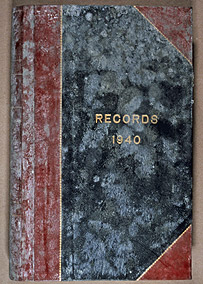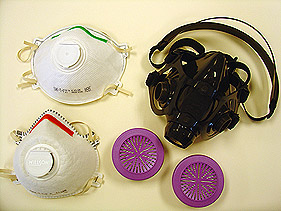
mold protection
1 Preventing Mold | 2 Responding to Mold
|
|
Mold spores are everywhere. Mold and mildew are types of fungi, microorganisms that depend on other organisms for sustenance. There are over 100,000 known species of fungi. The great variety of species means that patterns of mold growth and the response of mold in a particular situation can be unpredictable.
Molds excrete enzymes that allow them to digest organic materials such as paper and book bindings, altering and weakening those materials. In addition, many molds contain colored substances that can stain paper, cloth, or leather. It is important to realize that mold can be dangerous to people and can in some cases pose a major health hazard. Mold outbreaks should never be ignored or left to "go away on their own."
1 Preventing Mold
There are a number of factors (including high temperature, stagnant air, and darkness) that influence the growth of mold in buildings and on collections, but the single most important factor in mold growth is the moisture content of the materials on which the mold is growing. If there is sufficient moisture, mold will become active (germinating and releasing spores that spread the mold further).
|
|
High moisture content is most often the result of high relative humidity or of the dampness or wetness of collections. Paper collections are hygroscopic, meaning, they absorb and release moisture and will come to equilibrium with the surrounding atmosphere. The best way to prevent mold growth is to control humidity levels in all areas where collections are stored, and to keep the temperature moderate. General cleanliness and good air circulation also reduce the risk of infestation, although -- in order to avoid spreading mold spores -- it is a good idea to limit air circulation once mold growth has occurred.
In the case of flood or other water damage, experience has shown that mold growth will occur within 48 to 72 hours if action is not taken to reduce the humidity and dry the materials, carpeting, and furnishings. Identify and correct water hazards in your building, such as damp basement walls, leaky roofs, dripping pipes, as quickly as possible to avoid the development of mold.
See Session 8: Emergency Preparedness for more information about water hazards and a sample Water Damage Prevention Checklist.
2 Responding to Mold
Mold must be dealt with promptly and in an appropriate manner. Under no circumstances should staff members work with moldy collections unprotected, and staff members with a known sensitivity should not work with moldy materials at all.
Health Hazards
Even small amounts of mold can be a serious health hazard to your staff and patrons. However, there are no federal or state regulations that govern exposure to mold as there are for exposure to asbestos and other hazardous substances. The effects of mold will differ depending on the type of mold, the level of exposure, and the susceptibility of the person(s) exposed.
|
|
Personal Protective Equipment
A paper dust mask does not provide sufficient protection for working with mold; a respirator must be worn. A staff member should be trained and fit-tested with a respirator to respond to any mold outbreaks. Protective clothing, gloves, and eyewear are also recommended.Response Procedures
You may be able to respond in-house to a very minor mold outbreak in your collection, but if you are faced with a serious mold problem that affects a significant portion of the collection and/or the building, you will almost certainly require the assistance of an outside vendor (preferably one that has worked with cultural institutions before). For more information, refer to NEDCC's preservation leaflet 3.8 Emergency Salvage of Moldy Books and Paper.



